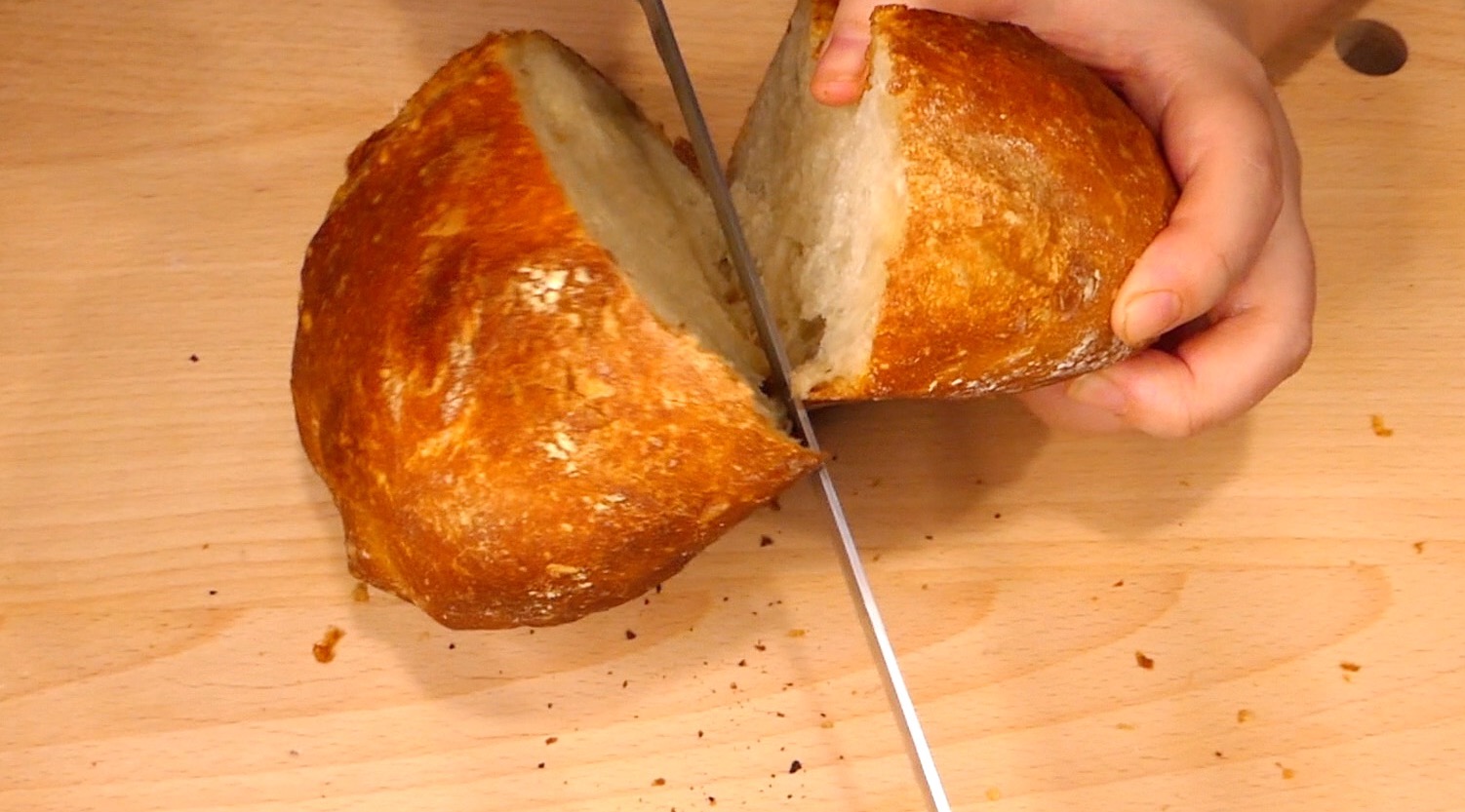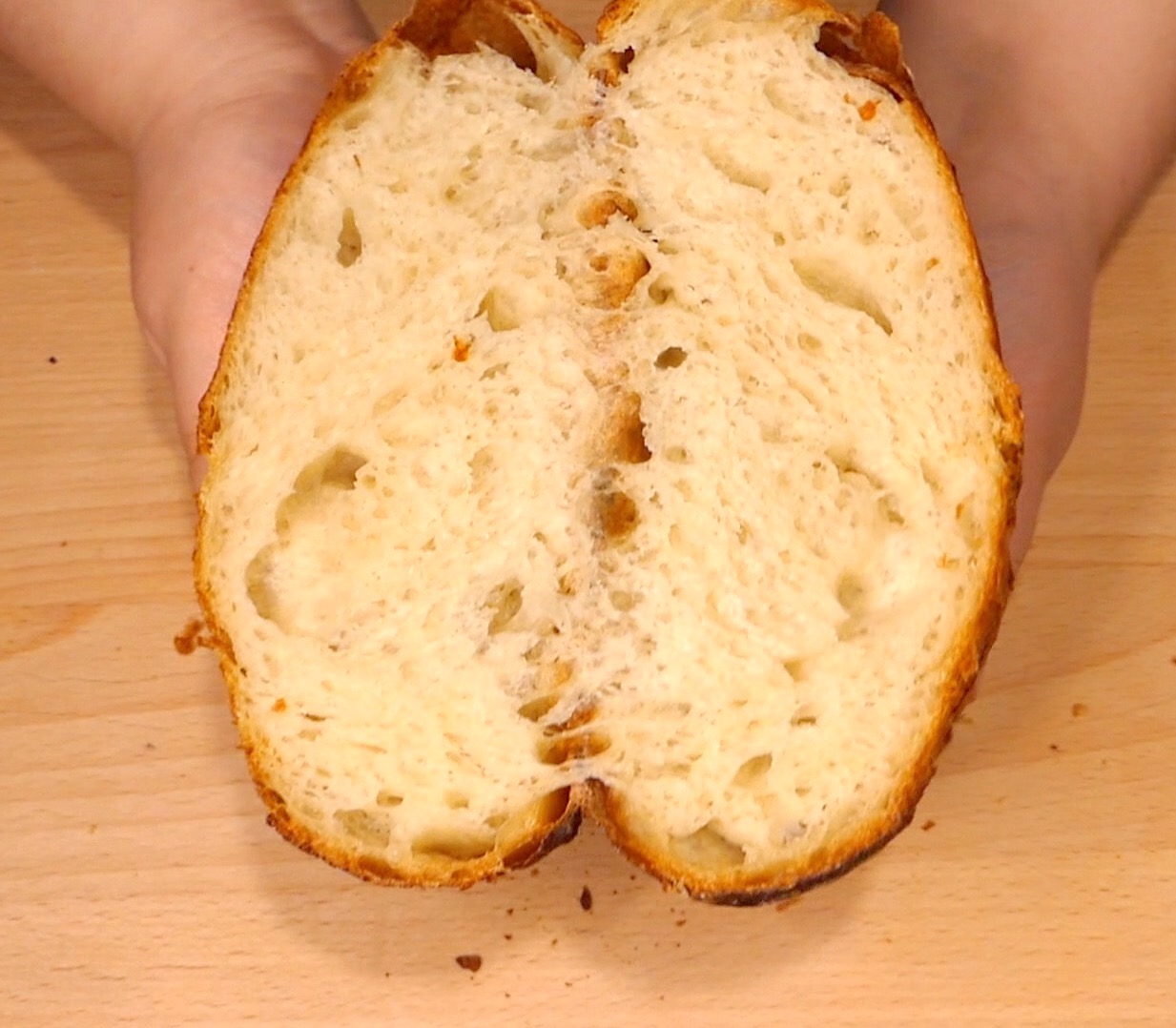Webman’s Garlic tuscan bread, a humble looking, truly one-of-a kind bread. If you’ve had it you must understand the obsession to copycat it. So soft, moist, and flavorful. A rare artisan bread with the tender crumb of the industrial white bread, yet the flavor and crust that rivals a good french baguette.
This is a faithful copy cat that will in fact use everything on the ingredient list. After many adjustment to get close to the real deal, I believe ~80% hydration on a high gluten bread flour yield the closest result, with open crumbs and a light texture. If you’re using all purpose flour with this recipe, I would lower the hydration to ~75% if not lower, due to the lower water absorption rate of the lower gluten flour.
Ascorbic acid, also known as Vitamin C, is a common commercial additive that makes the bread rise higher and last longer. It is often used in trace amounts, a tiny pinch goes a long way. The chain baker has an amazing side-by-side video that is super informative on the effect. You can substitute with lemon juice, or by extension (to a lesser extent), citric acid - if you don’t feel like crushing up some vitamin c pills or buying a packet.
For ease of replicating, is a no-knead recipe. No stand mixers, just let autolyse do the work. It will require one fold before the long cold fermentation, and one fold after. Sticky high hydration dough can be intimidating for newbies. Here's a lifesaver tip that I wish I had known earlier: wet your hands with water before kneading. It keeps the dough away from sticking to your finger, and unlike greasing the hand with oil, keeps the dough lean and clean and won't affect gluten development. This is a low-active time recipe, but will take quite a bit of waiting. give the dough at least 12 hrs in the fridge, and let it fully proof until doubled in size. Do not rush the proofing. Under-proofed dough can be much denser and lose all the appealing textural benefit that we applied all the special ingredients for. This is best made with a dutch oven, assuming you don't have a steam/combo oven at home. If you don't have any lid'ed oven-safe container to bake with, you can spray the bread with some water before putting it in the oven. Like with any fresh baked bread, you'll want to resist cutting into it while it's piping hot. The rapid moisture evaporation will leave you with a more dried up dough as it cools.
To enjoy peak texture, Ingredients:

Amylase powder is commonly used in beer making, and in recent years, popular for making plant-based milk-alternatives such as oat milk - which due to its high starch content, would be slimy when heated without the help of amylase. It is also handy for making bean-based food (such as hummus or Azuki bean paste) more creamy/smooth and less grainy. If you like branching out experimenting with different food, this enzyme has many uses around the kitchen; but if bread making is your only goal for now, I would skip this and just buy the diastic malt, which effectively does the same thing while contributing more to browning, oven spring, and complexity of flavor.Soy lecithin is another 'cheat' ingredient that yields consistent results with no skills involved. It is chemically similar to adding egg yolks (another natural source of lecithin), and as a fat replacer, it has a textural effect similar to adding butter or oil. Though not a perfect replacement, you can somewhat get the effect of an enriched brioche bread from a lean dough that is much easier to work with. It will result in noticeably more soft and tender crumb - but the effect will be reflected in texture only; it won't impart the flavor that you'd get from butter or egg. It is also an effective emulsifier for salad dressing and ice cream. But like in bread, it's only effective in helping newbies yield reasonably good result - so purchase with reasonable expectations, if you're interested in the chemical helper.
For ease of replicating, is a no-knead recipe. No stand mixers, just let autolyse do the work. It will require one fold before the long cold fermentation, and one fold after. Sticky high hydration dough can be intimidating for newbies. Here's a lifesaver tip that I wish I had known earlier: wet your hands with water before kneading. It keeps the dough away from sticking to your finger, and unlike greasing the hand with oil, keeps the dough lean and clean and won't affect gluten development. This is a low-active time recipe, but will take quite a bit of waiting. give the dough at least 12 hrs in the fridge, and let it fully proof until doubled in size. Do not rush the proofing. Under-proofed dough can be much denser and lose all the appealing textural benefit that we applied all the special ingredients for. This is best made with a dutch oven, assuming you don't have a steam/combo oven at home. If you don't have any lid'ed oven-safe container to bake with, you can spray the bread with some water before putting it in the oven. Like with any fresh baked bread, you'll want to resist cutting into it while it's piping hot. The rapid moisture evaporation will leave you with a more dried up dough as it cools.
To enjoy peak texture, Ingredients:
- 180g bread flour (or 200g all purpose)
- 20g durum wheat flour (semolina)
- 160g water
- 1/2 tsp sea salt
- 1/4 tsp yeast
- 1/8 tsp amylase enzyme powder
- 1/8 tsp ascorbic acid (vitamin c)
- 1/8 tsp diastic malt powder
- 1/8 tsp soy lecithin
- garlic oil for topping
Instructions:
- Dissolve everything except the bread flour in water first, then add bread flour and mix until no dry flour remains.
- Rest the dough for 1 hr. Lightly wet your hand to prevent sticking, and stretch the dough from edge of the bowl to the center to fold; repeat around the bowl and fold into a smooth dough ball and leave in the fridge for 12~24hr.
- Press out large air bubbles; fold one more time and shape into a dough ball. Proof until doubled in size.
- Preheat oven to 420F with dutch oven in it. Bake with lid on for ~30min, then with lid off for 10~15min, until color reaches desired browning.
- Brush the hot loaf with garlic oil. Let cool until crust softens before slicing. Enjoy!











Comments
Post a Comment